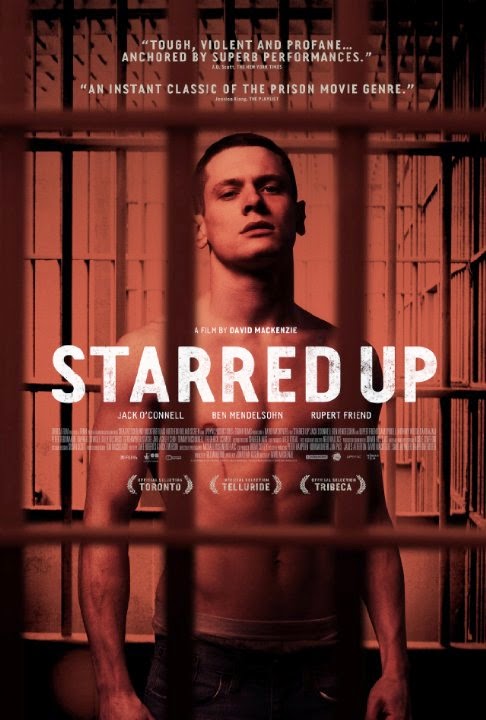 Starred Up
is a movie about the futility of the justice system. We send people to prison,
they lose contact with their children, they become part of the prison-culture,
their children are brought up without a parent, and the children join their
parent(s) in prison.
Starred Up
is a movie about the futility of the justice system. We send people to prison,
they lose contact with their children, they become part of the prison-culture,
their children are brought up without a parent, and the children join their
parent(s) in prison.The cold emotional/psychological reality that prisoners inhabit is manifested by Starred Up’s cinematography and music. The lighting is dark and there is no music. The clothes are grey and the buildings bland. Viewers are forced into the sensory experience of what prison would feel like. Viewer sensory arousal comes due to the anger and hatred that prisoners express on a continuous basis: the sensations we are made to feel are not pleasurable, but exhilarating in a dangerous, chaotic way.
The movie focuses on the movement of an angry British man named Eric Love (Jack O’Connell) from the youth ward into the adult prison. This is what the term Starred Up means. He clearly has antisocial personality disorder, and his only enjoyment in life seems to be pressing back against any kind of authority: perceived or otherwise. As the movie plays out it becomes clear that much of this rage comes from the troubled relationship he shares with his father Neville Love (Ben Mendelsohn), who is in the same prison ward.
The other central aspect to the movie is the attempt of a psychologist to help the prisoners with their anger. The classes appear to help some of the prisoners to a small extent. The point being that no matter how broken prisoners are they can improve; but improvements take time and the changes will often be small.
The relationship between the prison management and the psychologist is one of the weak points of the movie. Rather than presenting the prison management as not promoting rehabilitative services due to fiscal restraints or jadedness, Starred Up instead shows them as aggressively thwarting any attempts at rehabilitation. Prison management is presented in a one-sided and over the top fashion. This betrays the broader realism of the movie.
The movie finishes with a somewhat positive message of family affection staying strong regardless of what is said and done. I’m uncertain whether this message works in the midst of all that happens. Is the movie saying that this is a silver lining to all the other trauma and loss? Without going into detail, I feel that the movie once more plays against itself. If this part of the movie is taken as realistic (which is doubtful), it is pointless as it presents something that is supposed to be positive but without any tangible results for those involved. It is a whimpering, limp positive message that is simultaneously incongruous with the rest of the movie.
My verdict of this movie is that it loses its identity as it progresses. The lighting and sound captures the bleak emotional landscape of the individuals that inhabit the prison. The prisoners are presented in a realistic fashion; individuals with both strengths and weakness: prone to violence but also at times able to reflect and change. The psychologist likewise has his own anger issues, and does not manage to cure the prisoners of their demons through some therapeutic magic. Yet at times Starred Up falls into exaggerations and black-and-white portrayals of characters. It is a movie that is brutally realistic but often falls into cliché.